Calculation of the wire cross-section by power consumption
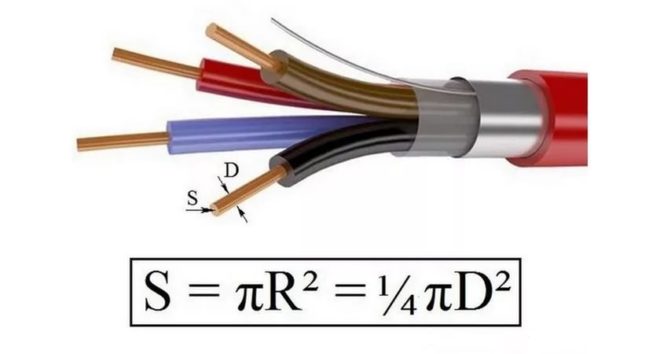
In case of replacement or laying of electrical wiring, it is necessary to accurately calculate the parameters of the cable that will be used. One of the key parameters is the cross-section of the wire, which determines which power load can be connected to the wire. A wire that is too weak may not withstand the load, and with an excessively large cross-section it will cost several times more. It should also be borne in mind that the smaller the cross-section of the conductors, the greater their electrical resistance, so it is also necessary to take into account the length of the wire and the way it is laid.
Content
What you need to know
If you cut any cable, then under the layers of insulating material, a wire core will become visible, which is the conductor of electric current. When the wire is cut (cut), then at the cut point, the core is visible as a circle, the area of which is called the cross-section of the wire core and is measured in mm² (square millimeters). Therefore, choosing the optimal wire cross-section, in fact, the diameter of its current-carrying conductors is selected.
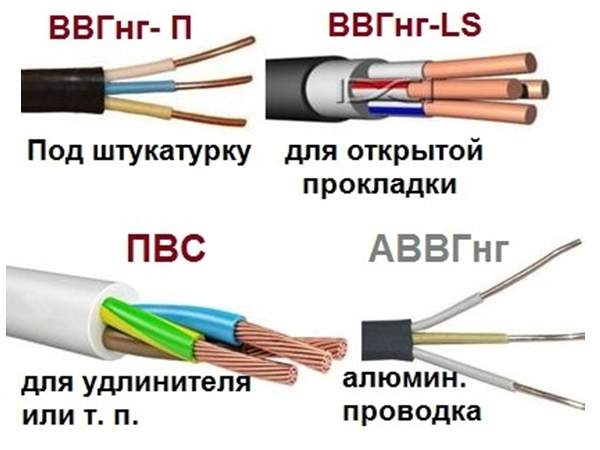
Since the conductive part of the cable is metal, and the insulation is made of PVC, rubber or similar materials, the wires can be conditionally divided into three levels according to the level of resistance to abnormal situations:
- The conductor and insulation are kept intact. Those. overheating of the wire occurred within the permissible limit and nothing happened.
- The insulation melts, but the core metal remains unchanged. After the breakdown is eliminated, further operation of such a wire is impossible - it requires mandatory replacement.
- Combustion of insulation and melting of the metal base. This is usually the consequence of a short circuit.
Knowing how to calculate the cross-section is exactly what is needed to exclude the second and third options, because in addition to the cable itself, protective devices are selected for wiring that turn off the line when the current increases.
Sorting basics
The only way to pick up a high-quality wire in an apartment or house across the cross-section of a current-carrying conductor is to know what power the devices will be connected to. This method is also called "by load", since in electrical circuits, all connected devices are considered as load or resistance.
First you need to determine the power of the devices. This can be done in several ways:
- find information about it in the technical passport of the device;
- the power is indicated on the devices themselves - usually it is indicated on metal plates or stickers, although they can simply be marked on the case.
- measure the current strength during operation and calculate the power - an exotic method that is used in exceptional cases when accurate results are needed.
If the device is made in Russia, Ukraine or Belarus, the power on it is always indicated as W (watt) or kW (kilowatt). If the product is European, Asian or American, the letter is W. The load used on such devices is designated as "TOT" or "TOT MAX".
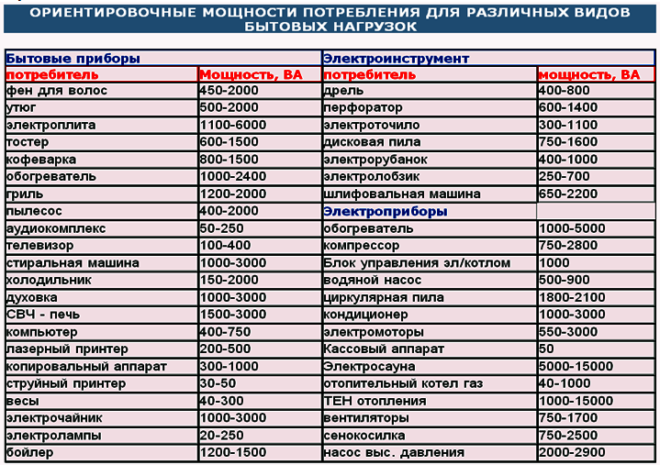
If it was not possible to accurately establish the power of the device, you can take the average data for calculation.
This means that in this case it is necessary to take into account the maximum possible power of the devices and select the appropriate cable cross-sections for them in terms of power consumption. Otherwise, the cable may overheat during operation, up to a fire in the insulation.
How to calculate
When calculating the cross-section of a wire, you need to remember a simple pattern - the more devices connected to it consume current, the larger the diameter of the core and the more massive the wire itself. The easiest way to determine the cross section is in a single-wire core using the following formula:

Here d - means the diameter of the core (mm), and S - the required cross-sectional area (mm²).
It is a little more difficult to calculate the diameter of a multi-wire core - here you need to measure the diameter of each individual wire and find their average value, then the formula takes the following form:

Where n is the number of cores, d is the average diameter, S is the sought-for cross-sectional area. It is also allowed to measure the diameter of one wire and multiply the result by their number. The formula remains the same, only d is now not the average diameter, but measured along one wire.
If a lot of calculations are foreseen, then you can calculate the cross-section of the wire using a special calculator of cable cross-sections online, in which you just need to enter all the data about the number and diameter of the current-carrying conductor and it will give the result.
Features of the cross-section of electrical wiring from different materials
Aluminum wiring, which was used back in Soviet times, is now prohibited for the installation of internal wiring, but is still used as the most budgetary option, despite its relatively low service life and overall reliability. When overheated, it begins to crumble, oxidizes faster in air and has a lower electrical conductivity - this means that with the same cross-section of wires, copper is able to pass more current through itself than aluminum.

A copper cable has significant strength and resistance to corrosion, so if you have to change all the wiring, it is strongly recommended to use a copper cable, especially since this is a direct requirement of the PUE. Since copper wire is more expensive than aluminum, knowing the appropriate power cross-sectional values when using it will be a significant savings for the estimate.
When laying hidden wiring at home, it is better to choose a single-wire cable, since it is easier to install and does not require additional steps.
Most often, such wires are used to connect non-stationary devices to the network: hairdryer, iron, razor and others.
There is a general calculation for standard wiring of apartments, houses, cottages. According to him, with a continuous load of 25A, wire cross-sections for current (copper) 4.0 mm² and a diameter of 2.26 mm are used. In accordance with these calculations, a circuit breaker (automatic machine) is installed on the line, which is usually mounted in the lead-in box at the point where the wires enter the apartment or house.
Cross-section of cables with open or closed wiring
When the current pulses move along the conductor, it heats up. The more current, the stronger the heat. The same current flowing through wires of different diameters has an ambiguous effect on heat generation. The smaller the cross-section, the more heating occurs from the load.
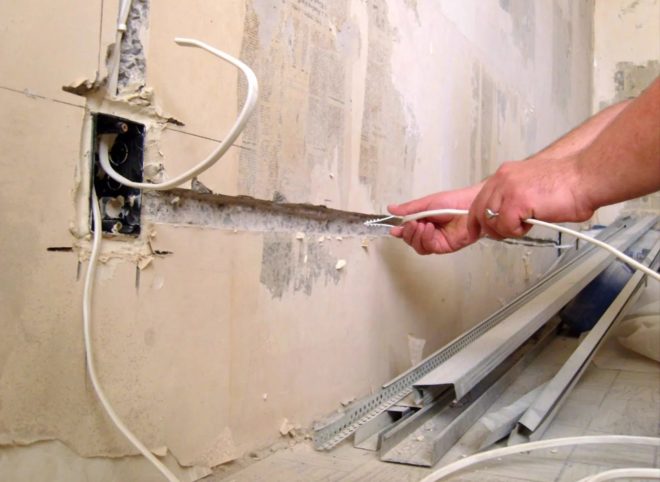
Therefore, if the line is made open, you can reduce the cross-section - take less strong wires. In this case, it cools down faster and the insulation does not deteriorate.With a closed installation method, the situation is worse - the heat goes away more slowly, and here a stronger material is already needed - wires of a larger cross section.
Designing the wiring and buying the right amount of consumables requires design skills. You will need to do the following:
- Draw a plan of an apartment or other premises where it is planned, and mark future sockets and lamps.
- Find out the power of all available devices and home appliances: lamps, heating appliances, kettles, hair dryers, etc. This will allow you to stay at the best option.
- Measure the length of the planned line and add all the collected parameters together.
- Select a brand of cable. It is better to use flat wire for internal wiring.
- Buy the required amount.
The generally accepted color of core insulation does not depend in any way on their cross section and is used only for ease of installation:
- blue - for neutral;
- yellow-green - grounding;
- white, brown and others - phase conductors.
It is better to install several switches and immediately sign them: for example, "kitchen", "bedroom", etc. The lighting line is always drawn separately from the input machine and does not depend on the sockets. Even if a short circuit occurs in one of them, the house will not remain without light, and, if necessary, repairs can be done with normal lighting, without using a flashlight or candles.
Additional recommendations:
- It is always better to choose the cross-section of the wire with a margin - saving is good, but it should be reasonable, and it is not known what will be included there later.
- In rooms with high humidity, it is very likely that two layers of insulation may be needed.
- When buying, you need to specify the permissible bending diameter of the wire, especially for single-wire ones. The fact is that if you just bend the cable, then the conductivity may deteriorate in this place, so manufacturers always indicate the permissible bending radius, starting from the outer diameter of the entire cable. Most often, this value is 10-15.
- Copper and aluminum cables do not fit or connect in the usual way. For their fastening, you can use special terminal blocks or washers (galvanized).
How to calculate the parameters of the required cable
If the power line is of impressive length (100 meters or more), then all calculations must be done taking into account the current losses that will occur directly to the cable. This is done without fail when designing the power supply of houses. All initial data are entered into the project in advance, for control and reinsurance they are rechecked using the power rate allocated for the entire house and the length from it to the pole. The following table helps to calculate the required parameters:
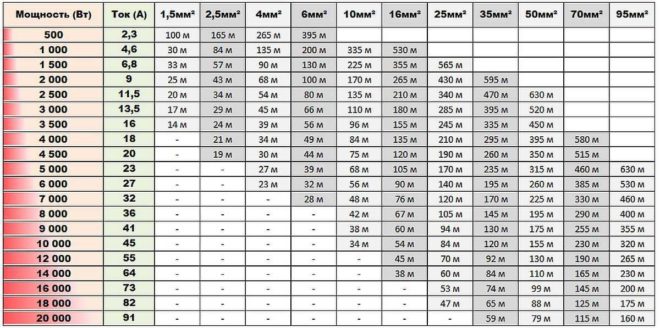
The choice of a suitable wire cross-section when installing electrical wiring is best done with a margin. If there is one, all new devices that have appeared in the apartment can be safely turned on without fear of overload.
If you urgently need to lengthen the outlet, and the required wire is not nearby, you can use different cables by connecting them parallel to each other. This method is not used constantly, but resort to it in moments of extreme necessity, but if it is already used, and even more so to connect a powerful device, then you need to use wires of the same cross section. If this requirement cannot be met, then when calculating whether the wire will withstand, only the cable of a smaller cross-section must be taken into account.
Converting watts to kilowatts
When specifying power for large electrical appliances, units such as watts and kilowatts are used.The prefix "kilo" means that the number must be multiplied by 1000, therefore 1kW = 1000 W, 5 kW = 5000W, 3 kW = 3000W, and 1W = 0.001 kW, etc.
Devices that consume such a low amount of current that even it does not need to be selected include:
- refrigerator;
- Charger;
- TV;
- radiotelephone;
- night lamps and floor lamps.
But if, for example, a heater is connected to the same outlet, then calculations must be done.
Choosing which cable cross-section will be used is the most important component of any electrical circuit design, from premises to city or industrial networks. Correct selection ensures electrical, fire safety and economy of the project budget.
Useful videos




